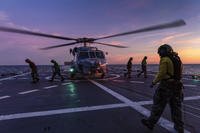The Marine Corps would like to cut by half the amount of time it spends studying a replacement for its never-was Expeditionary Fighting Vehicle, reports Michael Fabey of AvWeek. Ideally, the Corps would like to complete its analysis of alternatives in about six to nine months -- as opposed to the year or 18 months it might normally take, said Lt. Gen. George Flynn, the head of Marine Corps Combat Development Command.
Sometimes, DoD uses its culture of "analysis" and "study" as a way to delay decision-making -- oh, senator, we don't know what color the drapes should be in the secretary's new office; we're waiting on an AoA that looks at the full range of options from soup to nuts. In this case, however, the Marines know they need to get started on this post-EFV vehicle ricky tick, because in Austerity America the services are going to be at each other's throats trying to get their priorities into the budget. The longer the Marines take deciding what to buy, the slimmer their chances they'll get it.
So can they do it? The Corps seems to think it's got a good head-start with all it has learned from its decades of work on the EFV. Fabey writes:
Marines are using data from the EFV development — and still conducting further tests on the vehicles for even more information — to fast-track a more complete analysis of what is really needed for such a vehicle, he says.The corps is using the current EFV prototypes, for example, to design better “habitability” inside the vehicle, looking to develop items like an artificial horizon. The Marines also have reached out to shipbuilders, Flynn says, to help develop a better hull design. “We’re trying to get a fix on the requirements side,” he says.
In an ideal world, then, the Marines would be able to take the things they know worked well about the EFV, including its weapons, for example, or engine and other components, and graft them onto a new, more reliable swimming hull. But that goal of reliability may mean the new vehicle doesn't have the transforming bow ramp that the EFV had, and as such may not be able to skim over the water at its same high speeds.
What'll be interesting is whether the Navy and Marines update their amphibious doctrines to make room for their new vehicle, or whether they'll keep the same assumptions and try to somehow get a cheaper EFV Lite. The Navy and Marines believe that in tomorrow's amphibious operations, the proliferation of guided anti-ship missiles will make it too dangerous for Navy assault ships to stand very close to the coast. So the Marines needed the high-speed EFV to get to shore quickly on the assumption the fleet would take station over the horizon, far away from the beach.
If that scenario changes, the Marines might be able to get away with a slower, compromise vehicle. Using the magic of doctrine and strategy, for example, the Navy and the Marines might decide that because tomorrow's fleet will have smothering fire support from the Advanced Gun Systems aboard the new Zumwalt-class destroyers, or better protection from the Navy's planed integrated air and missile defense systems, the missile risk is diminished. That, in turn, could mean the fleet would come closer to the beach to loose its New Amphibious Vehicles and their dangerous cargoes of Marines.
Whatever the services decide, it sounds like the Marine Corps wants to get there as quickly as it can.








